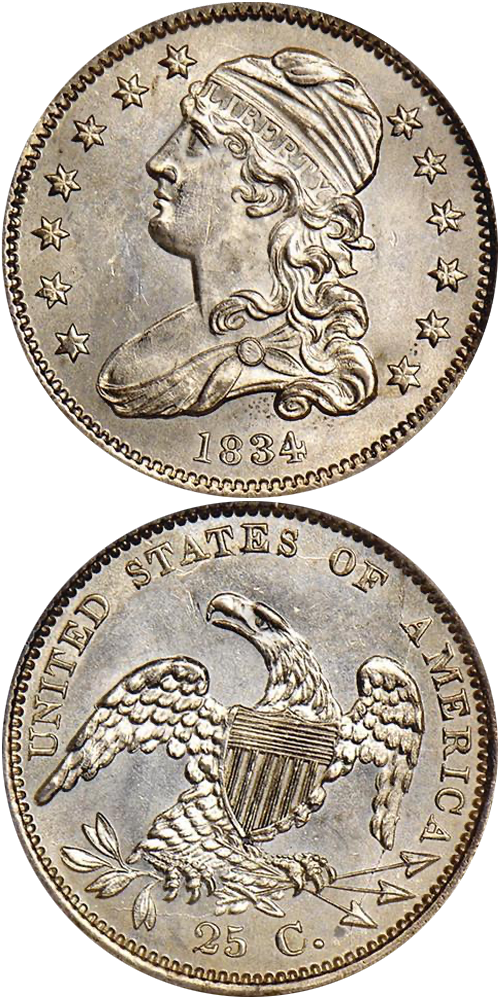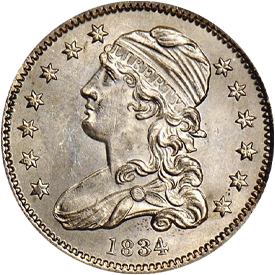Designed by: William Kneass (after John Reich)
Issue Dates: 1831-1838
Composition: 89.24% silver, 10.76% copper
Diameter: 24.3 mm
Weight: 6.74 grams (104.01 grains)
Edge: Reeded
Business Strike Mintage: 4,202,400
Following a lapse of coinage of quarter dollars for two years, the denomination was again produced in 1831. Employed was a revised version of John Reich's Capped Bust style introduced in 1815. The 1831-1838 version is of smaller diameter and has restyled features, letters, stars, and numerals, giving the piece a more cameo-like appearance than its predecessor. The obverse depicts Miss Liberty facing left, wearing a cloth cap secured by a band inscribed LIBERTY, with tresses flowing to her shoulder. Her neckline is draped in a gown secured by a brooch or clasp. Seven stars are to the left and six to the right. The date is below. The reverse shows an eagle perched on an olive branch and holding three arrows, with UNITED STATES OF AMERICA above and 25 C. below.
The type set collector has his choice of any date from 1831 through 1838, as all are priced approximately the same in the market, although certain dates, 1835 in particular, are more plentiful than others. Examples are readily found in grades from Very Good through Extremely Fine. AU coins are scarcer, and pieces designated as Uncirculated are rare. Higher echelon Uncirculated pieces are very elusive.
Further Reading
Quarters of the 1831-1838 reduced-size period furnish little variation. The 1831 occurs with two different letter sizes, the so-called Small Letters and Large Letters issues. Actually, both types of letters are quite small, and the "small" variety might better be called "smaller." One variety (and not a rare one) of 1833 is struck from severely rusted and pitted dies. As examples from these dies exist in all grades, evidently these were regular strikes for circulation (as opposed to the possibility of being restrikes produced in later years for collectors). It is probably the situation that unused dies were exposed to dampness at the Mint for a few years and then were pressed into service, perhaps in 1838 when it was evident that the motif would be discontinued, so that their utility would not be wasted. Here is an unsolved American numismatic puzzle!
Quarters of the 1831-1838 years are readily available in grades less than Uncirculated, with most pieces seen being in the Very Good to Extremely Fine range. Pieces with extreme wear, such as Fair, About Good, and Good, are elusive, probably because examples did not remain in circulation after the silver price increases of the early 1850s (which resulted in widespread melting). Uncirculated specimens of varying degrees (MS-60 through MS 67) are seen occasionally, but no year is common. Particularly scarce seem to be issues toward the end of the series, 1837 and 1838.
Early quarters are occasionally collected by die varieties in addition to major dates and overdates, however the rarity of these pieces is such that numismatists with this specialty have been few and far between. Herbert Bergen, the California numismatist, collected pieces by Browning numbers (as delineated by A.W. Browning in his The Early Quarter Dollars of United States 1796-1838), but in recent times the writer has encountered no want lists of such varieties (Herbert Bergen's coins having been sold at auction by Jerry Cohen and Abner Kreisberg in the late 1970s). The Lahrman Collection, sold by Abe Kosoff, and the Reed Hawn Collection, sold by Stack's, had excellent representations of early quarters, as have several comprehensive American collections, the "Century," Anderson-Dupont, Garrett, James Stack, and other cabinets coming to mind.







